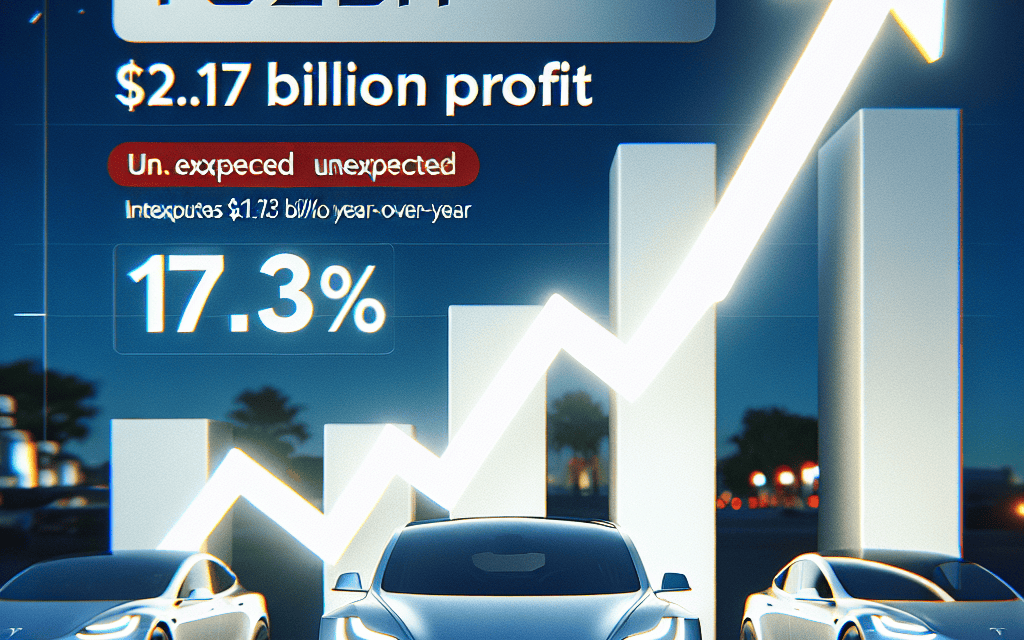“Tesla Surges Ahead: $2.17 Billion Q3 Profit Marks 17.3% Year-Over-Year Growth!”
Introduction
In a surprising financial disclosure, Tesla has reported a substantial profit of $2.17 billion for the third quarter, marking a significant 17.3% increase compared to the same period last year. This unexpected surge in profitability underscores Tesla’s robust performance amidst a challenging economic landscape, driven by strong sales figures and operational efficiencies. The electric vehicle giant’s impressive financial results highlight its continued dominance in the automotive industry and its ability to navigate supply chain disruptions and market volatility effectively. This announcement is likely to bolster investor confidence and further solidify Tesla’s position as a leader in the transition to sustainable energy solutions.
Tesla’s Q3 Financial Performance: Analyzing the $2.17 Billion Profit
Tesla’s recent financial disclosure has captured the attention of investors and industry analysts alike, as the company reported an unexpected $2.17 billion profit for the third quarter, marking a significant 17.3% increase year-over-year. This impressive financial performance underscores Tesla’s growing influence in the automotive and energy sectors, as well as its ability to navigate the complex challenges of a rapidly evolving market. The company’s robust earnings report not only highlights its operational efficiency but also reflects its strategic initiatives aimed at sustaining long-term growth.
One of the key factors contributing to Tesla’s remarkable profit surge is its increased vehicle production and delivery numbers. During the third quarter, Tesla managed to deliver a record number of vehicles, driven by strong demand for its Model 3 and Model Y. This surge in deliveries can be attributed to Tesla’s continuous efforts to expand its manufacturing capabilities, particularly with the ramp-up of production at its Gigafactories in Berlin and Texas. These facilities have played a crucial role in alleviating supply chain constraints and meeting the growing consumer demand for electric vehicles.
In addition to its vehicle sales, Tesla’s energy division has also made significant strides, contributing to the company’s overall profitability. The energy segment, which includes solar products and energy storage solutions, has seen increased adoption as more consumers and businesses seek sustainable energy alternatives. Tesla’s innovative energy storage products, such as the Powerwall and Megapack, have gained traction in various markets, further diversifying the company’s revenue streams and enhancing its financial resilience.
Moreover, Tesla’s strategic focus on cost management and operational efficiency has been instrumental in achieving its Q3 profit. The company has implemented various measures to optimize its production processes, reduce manufacturing costs, and improve supply chain logistics. These efforts have not only bolstered Tesla’s profit margins but have also positioned the company to better withstand external economic pressures, such as fluctuating raw material prices and global supply chain disruptions.
Furthermore, Tesla’s investment in research and development continues to be a driving force behind its financial success. The company’s commitment to innovation is evident in its ongoing advancements in battery technology, autonomous driving capabilities, and vehicle software. These technological developments not only enhance the appeal of Tesla’s products but also solidify its competitive edge in the electric vehicle market. By prioritizing R&D, Tesla is well-positioned to capitalize on future growth opportunities and maintain its leadership in the industry.
While Tesla’s Q3 profit is undoubtedly impressive, it is essential to consider the broader market dynamics that have influenced its financial performance. The global shift towards sustainable transportation and renewable energy has created a favorable environment for Tesla’s business model. Government incentives, increased consumer awareness, and a growing emphasis on reducing carbon emissions have all contributed to the rising demand for electric vehicles and clean energy solutions. Tesla’s ability to align its strategic objectives with these market trends has been a key factor in its continued success.
In conclusion, Tesla’s unexpected $2.17 billion profit for the third quarter is a testament to the company’s strategic vision, operational excellence, and commitment to innovation. As Tesla continues to expand its global footprint and diversify its product offerings, it remains well-positioned to navigate the challenges and opportunities of the evolving automotive and energy landscapes. The company’s strong financial performance not only reinforces its status as a leader in the electric vehicle industry but also sets the stage for sustained growth in the years to come.
Year-Over-Year Growth: Understanding Tesla’s 17.3% Increase in Profit
Tesla’s recent financial disclosure has captured the attention of investors and industry analysts alike, as the company reported an unexpected $2.17 billion profit for the third quarter, marking a significant 17.3% increase year-over-year. This impressive growth in profitability underscores Tesla’s robust performance in an increasingly competitive automotive market. To understand the factors contributing to this remarkable financial achievement, it is essential to examine the various elements that have played a role in Tesla’s success.
One of the primary drivers of Tesla’s profit surge is its continued expansion in global markets. The company has strategically increased its production capacity, particularly in its Gigafactories located in Shanghai and Berlin. These facilities have enabled Tesla to meet the growing demand for electric vehicles (EVs) in key regions, such as Europe and Asia, where environmental regulations and consumer preferences are increasingly favoring sustainable transportation solutions. By scaling up production, Tesla has not only been able to deliver more vehicles but also achieve economies of scale, thereby reducing per-unit costs and enhancing profit margins.
In addition to production expansion, Tesla’s focus on innovation has played a crucial role in its financial performance. The company has consistently invested in research and development to improve its vehicle technology, battery efficiency, and autonomous driving capabilities. These advancements have not only strengthened Tesla’s brand reputation as a leader in the EV market but have also allowed the company to command premium pricing for its vehicles. As a result, Tesla has been able to maintain a competitive edge over traditional automakers and new entrants in the EV space.
Moreover, Tesla’s strategic diversification into energy products and services has contributed to its profitability. The company’s energy division, which includes solar panels, energy storage solutions, and grid services, has seen increased adoption as businesses and consumers seek sustainable energy alternatives. This diversification has provided Tesla with additional revenue streams, reducing its reliance on vehicle sales alone and enhancing its overall financial stability.
Furthermore, Tesla’s adeptness in navigating supply chain challenges has been instrumental in its financial success. The global automotive industry has faced significant disruptions due to semiconductor shortages and logistical constraints. However, Tesla’s proactive approach in securing critical components and optimizing its supply chain operations has allowed the company to mitigate these challenges effectively. By maintaining production continuity and minimizing delays, Tesla has been able to capitalize on market opportunities and sustain its growth trajectory.
Additionally, Tesla’s financial performance has been bolstered by its strategic pricing adjustments and cost management initiatives. The company has demonstrated agility in responding to market dynamics by adjusting vehicle prices to reflect changes in raw material costs and currency fluctuations. Simultaneously, Tesla has implemented cost-saving measures across its operations, further enhancing its profitability.
In conclusion, Tesla’s unexpected $2.17 billion profit in the third quarter, representing a 17.3% increase year-over-year, is a testament to the company’s strategic vision and operational excellence. Through global market expansion, technological innovation, diversification into energy solutions, effective supply chain management, and strategic pricing, Tesla has positioned itself as a formidable player in the automotive industry. As the company continues to navigate the evolving landscape of sustainable transportation, its ability to adapt and innovate will be crucial in sustaining its growth momentum and delivering value to shareholders.
Key Factors Behind Tesla’s Unexpected Q3 Profit Surge
Tesla’s recent financial disclosure has taken the market by surprise, as the electric vehicle giant reported an unexpected $2.17 billion profit for the third quarter, marking a significant 17.3% increase year-over-year. This impressive performance has sparked considerable interest and speculation regarding the underlying factors that contributed to such a robust financial outcome. Several key elements have played a pivotal role in driving Tesla’s profit surge, each interwoven with the company’s strategic initiatives and market dynamics.
To begin with, Tesla’s ability to scale production efficiently has been a cornerstone of its recent success. The company has made substantial investments in expanding its manufacturing capabilities, particularly with the ramp-up of its Gigafactories in Berlin and Texas. These facilities have not only increased production capacity but have also optimized operational efficiencies, allowing Tesla to meet the growing demand for its vehicles more effectively. Consequently, the increased production volume has translated into higher sales figures, directly impacting the company’s bottom line.
In addition to production enhancements, Tesla’s focus on cost management has been instrumental in achieving its profit targets. The company has implemented various cost-cutting measures, ranging from streamlining supply chain operations to negotiating better terms with suppliers. By reducing production costs, Tesla has been able to maintain competitive pricing for its vehicles while preserving healthy profit margins. This strategic approach has enabled the company to navigate the challenges posed by fluctuating raw material prices and supply chain disruptions, which have affected the broader automotive industry.
Moreover, Tesla’s continuous innovation in product offerings has played a significant role in driving consumer interest and sales. The introduction of new models and updates to existing ones, such as the refreshed Model S and Model X, have kept the brand at the forefront of consumer preferences. Additionally, Tesla’s advancements in battery technology and autonomous driving features have further differentiated its vehicles from competitors, enhancing their appeal to tech-savvy consumers. This focus on innovation has not only bolstered sales but has also reinforced Tesla’s reputation as a leader in the electric vehicle market.
Furthermore, Tesla’s strategic expansion into international markets has contributed to its financial success. The company has made significant inroads into regions such as Europe and Asia, where demand for electric vehicles is on the rise. By establishing a strong presence in these markets, Tesla has been able to capitalize on favorable regulatory environments and growing consumer awareness of sustainable transportation options. This global expansion has diversified Tesla’s revenue streams and reduced its reliance on the North American market, providing a buffer against regional economic fluctuations.
Lastly, Tesla’s energy division, which includes solar products and energy storage solutions, has emerged as a noteworthy contributor to the company’s overall profitability. As the world increasingly shifts towards renewable energy sources, Tesla’s energy products have gained traction, offering consumers integrated solutions for sustainable living. The growth of this division has complemented Tesla’s automotive business, providing an additional revenue stream that supports the company’s financial objectives.
In conclusion, Tesla’s unexpected $2.17 billion profit in the third quarter can be attributed to a combination of strategic production scaling, cost management, product innovation, international market expansion, and diversification into energy solutions. These factors, collectively, have enabled Tesla to navigate the complexities of the automotive industry while maintaining its position as a leader in the transition to sustainable transportation. As the company continues to execute its strategic vision, it remains well-positioned to capitalize on future growth opportunities and further solidify its standing in the global market.
Market Reactions to Tesla’s Impressive Q3 Financial Results

Tesla’s recent announcement of an unexpected $2.17 billion profit for the third quarter has sent ripples through the financial markets, capturing the attention of investors and analysts alike. This impressive figure represents a 17.3% increase year-over-year, a testament to the company’s robust performance amidst a challenging economic landscape. As the news broke, market reactions were swift and varied, reflecting both optimism and caution among stakeholders.
To begin with, Tesla’s stock experienced a notable surge in value, as investors responded positively to the company’s financial results. The increase in profit, which exceeded analysts’ expectations, was largely attributed to a combination of factors, including increased vehicle deliveries, cost efficiencies, and a favorable product mix. This performance underscores Tesla’s ability to navigate supply chain disruptions and rising material costs, challenges that have plagued the automotive industry in recent times. Consequently, the market’s initial reaction was one of enthusiasm, with many investors viewing Tesla’s results as a sign of the company’s resilience and growth potential.
Moreover, the broader implications of Tesla’s financial success have sparked discussions about the future of the electric vehicle (EV) market. As a leader in the EV sector, Tesla’s performance is often seen as a barometer for the industry’s health. The company’s ability to achieve such significant profit growth suggests that consumer demand for electric vehicles remains strong, despite economic uncertainties. This has led to increased confidence among investors in the long-term viability of the EV market, prompting a reevaluation of investment strategies and priorities.
However, while the market’s initial response was largely positive, some analysts have urged caution, highlighting potential risks that could impact Tesla’s future performance. For instance, concerns about regulatory changes, particularly in key markets such as China and Europe, could pose challenges for the company. Additionally, the competitive landscape is evolving rapidly, with traditional automakers and new entrants alike ramping up their EV offerings. This intensifying competition could pressure Tesla to maintain its market share and profitability.
Furthermore, Tesla’s financial results have also reignited debates about the company’s valuation. With its stock price already reflecting high growth expectations, some market observers question whether the current valuation is sustainable in the long term. The company’s ability to continue delivering strong financial results will be crucial in justifying its market capitalization and maintaining investor confidence.
In light of these considerations, it is evident that Tesla’s Q3 profit announcement has had a multifaceted impact on the market. While the immediate reaction has been one of optimism, driven by the company’s impressive financial performance, there are underlying concerns that warrant careful attention. As Tesla continues to navigate the complexities of the global automotive industry, its ability to adapt and innovate will be key to sustaining its growth trajectory.
In conclusion, Tesla’s unexpected $2.17 billion profit for the third quarter has generated significant market reactions, reflecting both enthusiasm and caution among investors and analysts. The company’s strong performance has reinforced confidence in the electric vehicle market, while also highlighting potential challenges that could impact its future success. As the industry evolves, Tesla’s strategic decisions and execution will play a critical role in shaping its path forward, influencing not only its own fortunes but also the broader trajectory of the EV sector.
Tesla’s Strategic Moves Contributing to Q3 Profitability
Tesla’s recent financial disclosure has taken the market by surprise, as the company reported an unexpected $2.17 billion profit for the third quarter, marking a 17.3% increase year-over-year. This impressive performance can be attributed to a series of strategic moves that have not only bolstered Tesla’s profitability but also reinforced its position as a leader in the electric vehicle industry. As the company continues to navigate the complexities of a rapidly evolving market, several key factors have emerged as pivotal to its recent success.
One of the primary drivers of Tesla’s robust financial performance is its relentless focus on expanding production capacity. Over the past year, Tesla has made significant investments in its Gigafactories, particularly in Berlin and Texas, which have enabled the company to scale up production and meet the growing demand for electric vehicles. By increasing its manufacturing capabilities, Tesla has been able to reduce production bottlenecks and improve delivery timelines, thereby enhancing customer satisfaction and driving sales growth.
In addition to expanding its production capacity, Tesla has also been strategically diversifying its product lineup. The introduction of new models, such as the highly anticipated Cybertruck and the refreshed Model S and Model X, has generated considerable consumer interest and contributed to the company’s revenue growth. By offering a wider range of vehicles that cater to different market segments, Tesla has been able to capture a broader customer base and increase its market share in the competitive automotive industry.
Moreover, Tesla’s commitment to innovation and technological advancement has played a crucial role in its financial success. The company’s continuous efforts to improve battery technology and enhance vehicle performance have not only set it apart from competitors but also resulted in cost efficiencies that have positively impacted its bottom line. By reducing the cost of battery production and increasing the energy efficiency of its vehicles, Tesla has been able to maintain competitive pricing while preserving healthy profit margins.
Furthermore, Tesla’s strategic focus on expanding its global footprint has been instrumental in driving its profitability. The company has been actively pursuing growth opportunities in international markets, particularly in regions with high demand for sustainable transportation solutions. By establishing a strong presence in key markets such as China and Europe, Tesla has been able to tap into new revenue streams and mitigate the risks associated with market saturation in the United States.
Another significant factor contributing to Tesla’s Q3 profitability is its emphasis on enhancing operational efficiency. The company has implemented various cost-cutting measures and streamlined its supply chain operations to reduce overhead expenses and improve overall efficiency. These efforts have not only resulted in cost savings but have also enabled Tesla to allocate resources more effectively towards research and development initiatives, further strengthening its competitive edge.
In conclusion, Tesla’s unexpected $2.17 billion profit in the third quarter is a testament to the company’s strategic foresight and ability to adapt to changing market dynamics. By expanding production capacity, diversifying its product lineup, investing in innovation, and enhancing operational efficiency, Tesla has positioned itself for sustained growth and profitability. As the electric vehicle market continues to evolve, Tesla’s strategic moves will likely serve as a blueprint for other companies seeking to navigate the challenges and opportunities of this burgeoning industry.
Comparing Tesla’s Q3 Performance with Industry Peers
Tesla’s recent announcement of a $2.17 billion profit for the third quarter, marking a 17.3% increase year-over-year, has captured the attention of industry analysts and investors alike. This impressive financial performance not only underscores Tesla’s robust market position but also invites a comparison with its industry peers, many of whom are navigating a challenging economic landscape. As the automotive industry grapples with supply chain disruptions, fluctuating raw material costs, and the ongoing transition to electric vehicles, Tesla’s ability to deliver such strong results is particularly noteworthy.
In contrast to Tesla’s success, several traditional automakers have reported mixed results for the same period. For instance, General Motors, while maintaining a steady revenue stream, has faced pressure from rising production costs and a semiconductor shortage that has hampered its manufacturing capabilities. Similarly, Ford has experienced a decline in profit margins, attributed to increased spending on electric vehicle development and the impact of inflation on consumer purchasing power. These challenges highlight the broader difficulties faced by legacy automakers as they attempt to pivot towards a more sustainable future.
Meanwhile, other electric vehicle manufacturers, such as Rivian and Lucid Motors, are still in the early stages of scaling their operations. Although these companies have generated significant interest and investment, they have yet to achieve the production volumes and profitability that Tesla currently enjoys. Rivian, for example, has focused on ramping up its production capacity but continues to report losses as it invests heavily in infrastructure and technology. Lucid Motors, on the other hand, has made strides in delivering its luxury electric sedans but remains in the red as it seeks to establish a foothold in the competitive EV market.
Tesla’s ability to outperform its peers can be attributed to several key factors. First and foremost, the company’s vertically integrated supply chain has provided a significant advantage in mitigating the impact of global disruptions. By producing many of its components in-house, Tesla has been able to maintain a steady flow of materials and reduce dependency on external suppliers. Additionally, Tesla’s focus on innovation and technology has allowed it to continuously enhance its product offerings, thereby attracting a loyal customer base and driving sales growth.
Furthermore, Tesla’s strategic expansion into international markets has bolstered its financial performance. The company’s Gigafactories in China and Germany have not only increased production capacity but also enabled Tesla to tap into new consumer segments. This global presence has been instrumental in offsetting regional economic fluctuations and sustaining revenue growth.
In comparison, many traditional automakers are still in the process of restructuring their operations to accommodate the shift towards electric vehicles. This transition requires substantial investment in research and development, as well as the retooling of existing manufacturing facilities. Consequently, these companies face a delicate balancing act between managing current financial pressures and positioning themselves for long-term success in the evolving automotive landscape.
In conclusion, Tesla’s unexpected $2.17 billion profit for the third quarter serves as a testament to its strategic foresight and operational efficiency. While the company continues to set the benchmark for the electric vehicle industry, its peers are working diligently to catch up. As the automotive sector undergoes a transformative shift, the coming quarters will be crucial in determining which companies can successfully navigate the challenges and capitalize on the opportunities presented by this new era of mobility.
Future Outlook: What Tesla’s Q3 Success Means for Investors
Tesla’s recent announcement of an unexpected $2.17 billion profit for the third quarter, marking a 17.3% increase year-over-year, has sent ripples through the investment community. This impressive financial performance not only underscores the company’s robust operational capabilities but also signals a promising future for investors. As we delve into the implications of this success, it is essential to consider the factors contributing to Tesla’s profitability and what this means for its stakeholders.
To begin with, Tesla’s ability to achieve such a significant profit margin can be attributed to several key factors. The company’s strategic expansion into international markets, particularly in Asia and Europe, has played a crucial role in boosting sales. By establishing manufacturing facilities in these regions, Tesla has effectively reduced production costs and mitigated supply chain disruptions, thereby enhancing its competitive edge. Furthermore, the growing demand for electric vehicles (EVs) worldwide has provided a favorable backdrop for Tesla’s sales growth. As governments continue to implement stringent environmental regulations and consumers become more environmentally conscious, the shift towards sustainable transportation solutions is expected to accelerate, benefiting Tesla’s market position.
In addition to geographical expansion, Tesla’s continuous innovation in technology has been instrumental in driving its financial success. The company’s commitment to research and development has resulted in advancements in battery technology, which have improved the efficiency and range of its vehicles. This technological edge not only attracts environmentally conscious consumers but also positions Tesla as a leader in the EV industry. Moreover, Tesla’s foray into energy solutions, such as solar panels and energy storage systems, has diversified its revenue streams, contributing to its overall profitability.
As we consider the future outlook for Tesla, it is important to recognize the potential challenges that may arise. The automotive industry is highly competitive, with traditional automakers and new entrants alike vying for a share of the EV market. To maintain its leadership position, Tesla must continue to innovate and adapt to changing market dynamics. Additionally, fluctuations in raw material prices and potential regulatory changes could impact production costs and profit margins. However, Tesla’s strong brand recognition and loyal customer base provide a solid foundation for navigating these challenges.
For investors, Tesla’s Q3 success presents both opportunities and considerations. The company’s impressive financial performance is likely to bolster investor confidence, potentially driving up stock prices. However, it is crucial for investors to conduct thorough due diligence and consider the inherent risks associated with investing in a rapidly evolving industry. Diversification of investment portfolios and a long-term perspective can help mitigate potential risks and capitalize on Tesla’s growth prospects.
In conclusion, Tesla’s unexpected $2.17 billion profit in the third quarter is a testament to its strategic vision and operational excellence. The company’s ability to capitalize on global market trends and technological advancements has positioned it as a formidable player in the EV industry. While challenges remain, Tesla’s strong financial performance and commitment to innovation offer a promising future for investors. As the world continues to embrace sustainable transportation solutions, Tesla’s success story is likely to inspire confidence and optimism among its stakeholders.
Q&A
1. **What was Tesla’s profit in Q3?**
Tesla reported a profit of $2.17 billion in Q3.
2. **How much did Tesla’s profit increase year-over-year?**
Tesla’s profit increased by 17.3% year-over-year.
3. **What is the significance of Tesla’s Q3 profit report?**
The profit was unexpected, indicating stronger-than-anticipated financial performance.
4. **How does this profit compare to previous quarters?**
The profit represents a significant increase compared to the same quarter in the previous year.
5. **What factors contributed to Tesla’s profit increase?**
Factors may include increased vehicle sales, cost efficiencies, and expanded market presence.
6. **How might this profit report affect Tesla’s stock price?**
The unexpected profit could positively influence Tesla’s stock price, boosting investor confidence.
7. **What are potential challenges Tesla might face despite the profit increase?**
Potential challenges include supply chain issues, competition, and regulatory changes.
Conclusion
Tesla’s unexpected $2.17 billion profit in Q3, marking a 17.3% year-over-year increase, underscores the company’s robust financial performance and operational efficiency. This growth highlights Tesla’s ability to navigate supply chain challenges and maintain strong demand for its electric vehicles. The results reflect successful cost management and strategic expansion efforts, reinforcing Tesla’s position as a leader in the automotive industry and its potential for sustained profitability in the future.





